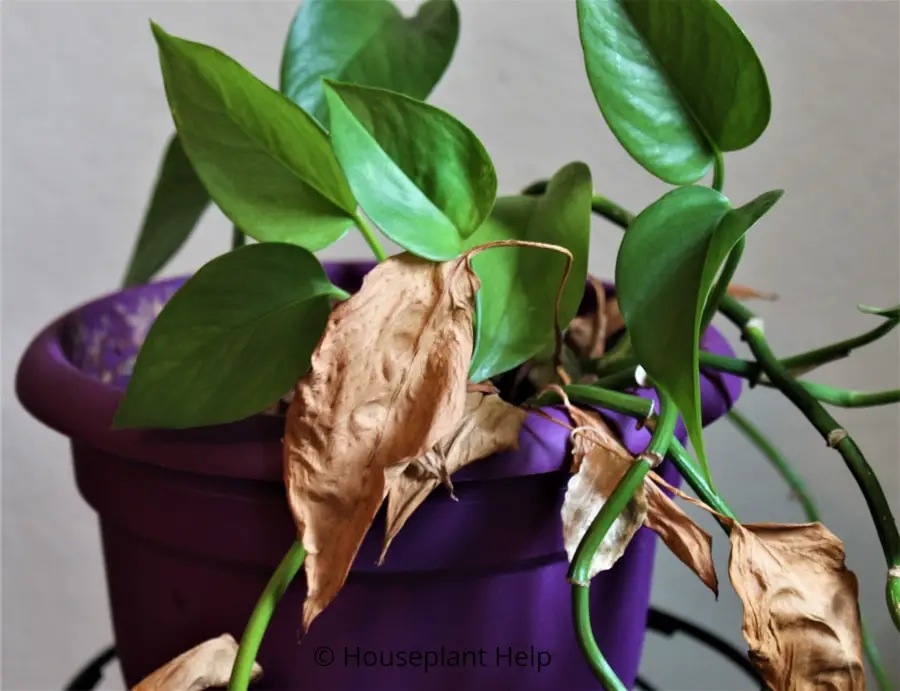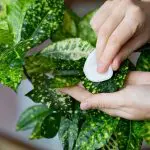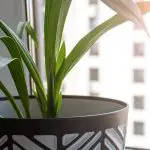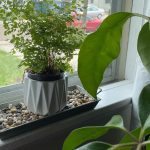
As we’ve learned to properly care for different house plants over the years, we’ve had our fair share of brown, dying leaves. In the beginning, we weren’t sure if we should remove them or leave them. Here’s what we’ve found works best.
Should you cut off dying leaves? Yes. Remove brown and dying leaves from your house plants as soon as possible, but only if they’re more than 50 percent damaged. Cutting off these leaves allows the remaining healthy foliage to receive more nutrients and improves the plant’s appearance.
Although it may seem simple enough, there’s more to it than just snipping off those leaves. You’ll need to consider how much of the leaf is dying and then remove the damaged parts properly to maintain your plant’s health.
Why You Should Cut Off Dying Leaves
There are three main reasons why you should cut off dying leaves:
- To free up nutrients and encourage new growth
- To prevent the spread of disease or pests
- To improve health and appearance
Dying leaves leach nutrients from the plant that are better used elsewhere. Removing them allows these nutrients to go where they’re needed most – the remaining healthy leaves and flowers. You don’t want your plant using its resources to maintain non-viable leaves.
In some plants, snipping off dead leaves may also encourage new growth during the plant’s active growing season.
If leaves have been damaged by a disease or pest problem, cutting them off as soon as possible may prevent spreading to other parts of the plant. Inspect any leaves you remove. If you think you have a disease or pest infestation, apply treatment immediately.
In addition, house plants with brown and dying leaves just don’t look nice. They look unhealthy and unappealing. Cutting off these problem leaves improves their health and attractiveness. In some plants, leaving on brown leaves can even cause the plant to decline at a faster rate.
When to Cut Off Dying Leaves
If a leaf is completely dead and brown, it’s safe to remove it immediately. Otherwise, consider the amount of damage first. Leaves that are less than 50 percent damaged or just have browned tips can be trimmed back and still survive.
If you don’t like the look of half-trimmed leaves, it’s okay to remove the entire leaf. Just make sure you remove it carefully with scissors (see tips below) and NEVER remove more than one-third of living leaves on a house plant.
Of course, you don’t have to remove brown or shriveled leaves. You can leave them on until they drop off naturally. Removing dying leaves definitely improves health and beauty, but it isn’t necessary for your plant’s life. The only exception is when you have a disease or pest problem – then remove the affected leaves immediately.
How to Remove Dying Leaves
For the best results, simply tug gently on the dying leaf and it should come free without much resistance. If it doesn’t come loose easily, you can either wait a few days and try again or grab a pair of clean garden shears.
We keep a special pair of shears reserved only for pruning our houseplants. You can check the price of our favorite brand here on Amazon. We’ve had great results with these, and they last for YEARS with proper maintenance.
NEVER tear the leaf off the plant if it doesn’t snap off easily. This can damage healthy tissue. If in doubt, use shears to prevent causing unnecessary harm to your plant.
To remove with shears, cut off the leaf as close to the stem as possible, being careful not to cut into the stem. Dispose of the dead leaves immediately after removal. Debris left on the soil is a breeding ground for pests and disease.
Cutting Off Brown Leaf Tips
You can trim off brown tips or edges without removing the entire leaf. Using your sharp plant shears, follow the natural shape of the leaf. If you make a blunt, straight-across cut, it will look unnatural. Trim off the damage following the leaf shape and the cut will blend naturally.
Spray the blades of your houseplant shears or scissors with disinfectant spray after each use to prevent the spread of disease and to keep them in good condition.
It’s not uncommon for older leaves to occasionally turn brown and die as your plant grows. In some cases, brown leaves may indicate a problem with light, water, nutrients, or disease. If leaves are constantly turning brown, make sure your plant is getting enough sun, water, and fertilizer.
Related Questions
Should I cut off yellow leaves? It depends. If you have a few yellow leaves that look unappealing and bother you, it’s okay to snip them off. But it isn’t necessary. If you have a lot of yellow leaves, you’re better off finding the problem and fixing it – such as overwatering or not enough sunlight.
Can leaves repair themselves? No, torn or split houseplant leaves will never heal. But your plant can grow new leaves to replace the damaged ones if you remove them or wait until they drop off. Drooping leaves may bounce back after they receive adequate water or fertilizer (or whatever they lack that’s causing them to droop).





